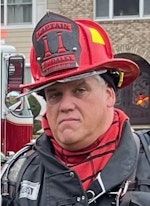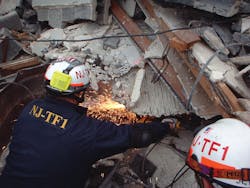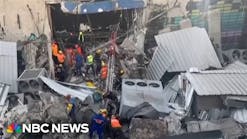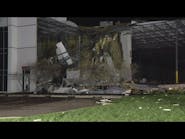First Due to a Building Collapse
Today’s emergency responders find themselves responding to a more diverse assortment of alarms than ever, so it would not be uncommon for initial-responding units to find themselves “first due” to a reported structural collapse. However, without proper training and preparation, these responders will find themselves inadequately prepared for this type of operation.
This article addresses the potential for a building collapse/compromise event in your own community, describes tactical and strategic considerations for the collapse response and defines the phases of collapse rescue and how to bring the incident to a successful conclusion.
Thorough planning
It is important to understand the need for thorough planning for this type of response. Structural collapses are not a normal, everyday occurrence for most responders. This alone sets up an opportunity for catastrophic injury, as rescuers are more prone to injury while performing skills that they do not use regularly, at incidents that they do not train on regularly. Many firefighters are of the mindset that, since the potential to respond to a collapse incident in their jurisdiction is minimal at best, the need for thorough training in this category is minimal as well. In fact, the rarity of this type of event helps to confirm the need for more training in this discipline. This lack of, or inadequate level of training, can be linked to a number of on-scene issues:
• Failure of the Incident Command System (ICS). The dynamic intensity of an emergency scene may overwhelm an inexperienced officer and it is up to the incident commander to control the response and operations. Moreover, should a collapse occur after initial units are on scene (i.e., resulting from a fire), the potential of responder loss will certainly create a chaotic scene for command.
• Freelancing. A large amount of rescuers will be a necessity on scene, performing a variety of tasks, including search, air monitoring, medical triage and shoring, to name just a few. With a high risk of changing conditions on scene, it is important to stay accountable for all rescuers operating.
• Hazardous materials presence. Rescuers who are operating at a collapse can become complacent about their surroundings while focusing on their tasks at hand. Collapses at occupancies with a high hazmat potential (such as hardware stores, plumbing supply stores and agricultural supply stores) will serve as an additional hazard as rescuers work their way through a rubble pile.
• Communications overload. Many agencies have the capability to talk on many different frequencies, but the reality is that some agencies cannot talk with other disciplines that are on-scene (fire, EMS police and other responders). There has to be a plan to handle on-scene communications. There also will be rescuers who have to fight for air time when a frequency becomes overloaded. There should be multiple channels for different operations to communicate on, but there should also be interoperability between each, so communications between rescuers can occur.
• Self-converging resources. It is not uncommon for units to self-dispatch to the “big one,” especially if it is a local incident. A well-planned response protocol will help to confirm the right resources will be called to the incident when they are needed to respond. Furthermore, these incidents can run through multiple operational periods. If all of the local resources are depleted during the initial response, there will not be an ample supply for the next operational period.
Why buildings collapse
Structures are built with two primary objectives in mind: to resist gravity and resist wind shear. In his book Building Construction for the Fire Service, the late Frank Brannigan wrote of the “Gravity Resistance System” that is designed into each structure. It is the combination of all of the structural elements and their connections that support the structure and direct these forces back into the ground. This “system” is the design result that keeps the structure from failing under ordinary, everyday usage.
To understand this system, the responder must have a solid knowledge of building construction. This is of paramount importance. This knowledge helps responders predict smoke and fire behavior; determine how a structure will behave when it is compromised; identify potential rescue problems; know the types of construction materials that will have to be breached and heavy structural components that will have to be moved; and predict occupant and utility locations.
Over the years, construction methods and techniques have changed, but what have not changed are the laws of physics. Many officers have learned their decision-making process through experience on the fireground; however, the clues that existed in the past, such as sagging floors and smoke coming from separations in walls, may serve to be “too little, too late.”
Today, buildings are constructed with approximately half of the materials used years ago, but are creating more than five times the amount of heat energy, resulting in faster destruction of structural components, and quicker collapse. It is best to have a grasp on the physical aspects of construction, mainly gravity, loads and forces.
Gravity has been called the greatest of firefighter enemies – unforgiving, unpredictable and always a factor for consideration. Twenty-four hours a day, seven days a week, gravity is continually exerting forces on a structure. Overall, these stresses may not be apparent, but they are still in place.
Loads can be defined as a force or action that is a result of the weight all building materials, occupants, environmental effects, and movement and changes that are applied during the normal use of the structure. Some loads are simply defined, such as a “dead load,” which includes the weight of structural components and all materials attached to the structure, and “live load,” which is anything not permanently affixed to the structure, such as furnishings, occupants and transient (temporary) materials and occupants. Some loads are environmental, like wind loads and distributed loads of snow on a structure’s roof.
When discussing forces, it is important to define two separate concepts: stress and strain. Stress, mostly measured in pounds per square inch (psi), results from external force applied to a structural component. Strain, conversely, is the actual deformation of a component when it is stressed. Strain is usually measured in per inch of original length of the component.
Generally, there are a few types of forces to be identified:
• Compression – A squeezing, compressive force placed on an object, pushing both ends toward each other (for example, a loaded upright column)
• Tension – A pulling force placed on an object, pulling both ends apart (for example, a steel cable on a suspension bridge)
• Bending – A directional force placed on the end of an object with an opposing force placed in the middle of an object (for example, a load placed on the center of a floor joist or continuous beam)
• Shearing – A force tangential to the object on which it is acting upon (for example, a pair of scissors or a rivet in an I-beam, with a downward force on the rivet)
• Torque – A twisting or torsional force placed on a structural component (for example, a nut on a bolt)
Collapse warnings
It is also important that the responders are well-versed in the signs and characteristics that a collapse may occur in their jurisdiction, such as:
• Age of the building. Most buildings, as a rule of thumb, have a life span of 75 to 100 years. Lack of proper maintenance will drastically reduce their life span.
• Weather. Buildings that are left open to the elements will deteriorate and rot quickly.
• Improper alterations. Building owners that take shortcuts or alter structural components without a proper knowledge of construction invite trouble.
• Natural disasters. Hurricanes, tornadoes and other storms can wreak havoc on a community and lead to a large collapse response, quickly overwhelming local resources.
• Construction collapses. There have been incidents where accidents on construction sites have resulted in catastrophic failures of structures.
• Vehicles into buildings. While most responders treat these incidents as nothing more than “nuisance” alarms, a damaged component can result in a domino effect, bringing down the rest of the structure without warning.
• Gas explosions. The routine “smell of gas” can turn deadly for responders. There have been cases across the country where firefighters have been injured and killed while investigating the source of the “smell.”
• Fires. The incident commander is faced with two problems at these incidents. The first problem is access to firefighters who may be trapped due to a collapse. The second problem is that the fire still has to be extinguished. Many departments train all of their resources on rescue and none on suppression, with catastrophic results.
Know what’s in your area
It would be wise for departments to perform an “Operational Capability Check” for their jurisdiction to identify their respective collapse potential. Identifying the types of construction in the area, combined with the age of buildings and their usage, will help identify high-risk structures for collapse.
This check includes an inward view of the department’s capabilities. Are members trained to handle these types of emergencies? Does the department have the tools necessary to operate on scene? Can the department handle both single-point responses (i.e., localized collapse) and multiple-point responses (i.e., widespread collapse due to natural disasters, explosions, etc.)? Is there a list of outside agencies and resources that will be needed to respond to the scene (engineers, urban search and rescue teams and equipment suppliers)? Trying to develop the resource list while developing the Incident Action Plan (IAP) is not a good idea; it puts the rescuer way behind the proactive curve.
Many fire departments have resource lists that are available for handling single-point responses that are dealt with on the local level, but multiple-point responses are a different story. Multiple-point responses are spread out over larger areas, involving many locations, and require a larger resource pool, including outside agencies, large-scale incident management support and technical expertise. An inventory of neighboring communities helps identify critical resources such as mutual aid companies, engineers, logistical support and state or local experts for response. This review should be done annually in order to keep the operational plan updated and accurate. Sunday at 2 A.M. is not the time to start shopping around for a crane to respond to the scene. Do your homework before the incident.
Working as a team
The collapse scene is not the place for freelancing and separation of crew members. Things can go wrong in an instant, and injuries and fatalities are often the result. It is vital that all of the responders understand that scene safety is an integrated part of training and discipline. Personnel must foster an attitude that identifies their skills and limitations and embraces the “team efficiency concept”. In his book Engineering Practical Rope Rescue Systems (2000), Mike Brown defines the team efficiency concept as “refining team member interaction to be productive without waste in every team endeavor.” This concept enforces the maximization of the member’s efficiency while considering safe operations as of equal importance. Working as a team for safer operations, staying focused on the assigned task and bringing the right equipment initially during the response are all examples of team efficiency. Your “team” should strive to coordinate, train and respond together with other local resources in a professional and commonly acceptable fashion.
Managing a response
Let’s look at the response to an actual incident. We can identify five phases of a collapse operation at any given incident:
• Reconnaissance. This phase is one of the most important phases of the operation, if not the most important. This stage sets the pace for the rest of the incident. This phase involves finding out what happened that led to the collapse, including a six-sided approach (front, rear, both sides, top and bottom) and can include:
1. Nature of the event (terrorism, structural failure, gas leak, tornado, etc.)
2. Type of construction type and materials used
3. Use of the building (occupancy)
4. A rough estimate of potential victims (this will vary, depending on occupancy)
5. Potential additional hazards
6. Incident scene control
7. Identifying potential survival locations
8. Utility control (local control at first, but start utility company representatives responding in)
9. Fire concern – did the fire cause the collapse or was it secondary to the collapse? Either way, suppression is a constant responsibility and concern at the incident
10. Develop the formal IAP
11. Initiate the Emergency Response Plan (ERP)
At this phase, responders are converging on the scene. Unfortunately, responses like this result in resources self-dispatching to the incident. It is imperative that all personnel on scene are identified, accounted for and properly assigned based on the priorities of the incident. The ERP should have already identified who is responding; now all that needs to be done is to assign them. Before being deployed, the crews attend a scene safety briefing that should include the following:
? Lookouts. These are safety officers whose critical functions include identifying potentially dangerous conditions and how to mitigate these issues.
? Communications. The formal plan including what channels each division or group will be operating on. There should also be an agreed-on method of evacuation and make sure everybody knows it.
? Escape routes. A pre-established path to an area of safety in chosen prior to entering. Note that the safest exit may not always be the fastest, but it is still the safest. Considering scene dynamics; this route may change as conditions do.
? Safe havens. Identify an area of safety immediately. This could be within the “hot zone” and must be passed on to everyone working in the area, especially during changes at the end of operational periods.
• Surface area rescue. Initial responders may be faced with multiple victims at the surface who may be incapacitated, walking wounded, lightly entrapped or fatally injured. Removing these victims takes priority, but further evaluation of the pile, along with searching for possible victim locations, should be going on at the same time. This helps identify areas where searching will start and appropriate resources can be deployed there.
• Void search. Personnel must check areas where survivability may be more likely. These include closets, under stairs in basements and cellars, rooms with blocked exits, loose piles of debris and voids that were created by the collapse. Furniture and belongings that were in the structure before the collapse can serve as load-bearing supports for debris, creating voids in which victims may seek refuge. Rescuers and technical experts will be constructing emergency shoring in the areas that they enter and building them in victim locations to assist in disentanglement operations inside the void spaces.
• Selective debris removal. During a search for victims and survivors, materials and debris are removed from the pile and replaced with emergency shoring as rescuers go deeper into the pile. The direction of travel is determined by a reconnaissance report and the results of the surface-area search. It is wise to stop and go “all quiet” during the operation and listen for sounds coming from victims in the pile. Calls for help, shouts and tapping on metal pipes and beams have all resulted in successful rescues of survivors in collapses worldwide.
• General debris removal. Transition into this phase of an operation usually marks the end of the “rescue period” and the beginning of the “recovery period.” In this phase, the pile is divided into sections for identification purposes. Debris from the pile is removed and sent to another location for further examination. The debris is evaluated for physical remains, personal artifacts and identification, clues to the cause of the collapse and further crime-scene analysis. No stone should be left unturned when all potential victims are unaccounted for. Once the material has been thoroughly searched, it should be marked to avoid duplication.
Conclusion
If this area of responsibility is within your jurisdiction, it is recommended that you gather all the training and education that is available to prepare for this type of response and further your education regularly. Keeping pace with the construction industry is one way to stay current. There are constant changes in the ways building go up and some of those changes are the primary reasons why these buildings come down.
In the end, you are primarily responsible for your own safety. Continue to do all that you can to protect yourself.
MIKE DALEY is a lieutenant and training officer with Monroe Township, NJ, Fire District 3 and an instructor at the Middlesex County Fire Academy, responsible for Fire and Rescue Training Curriculum development. Daley also is a rescue officer with the New Jersey Task Force 1 – Urban Search and Rescue team. He holds certifications as Rescue Technician, Incident Safety Officer, Hazardous Materials Specialist and On-Scene Incident Commander, EMT, Level II Fire Instructor, SCBA/Smokehouse and Live Burn Instructor, Fire Inspector, and Fire Officer. Daley holds degrees in business management and public safety administration. He is the founder and senior consultant for Fire Service Performance Concepts. He may be contacted at [email protected].

Michael Daley
MICHAEL DALEY, who is a Firehouse contributing editor, recently retired as a 37-year veteran who served as a captain and department training officer in Monroe Township, NJ. He is a staff instructor at multiple New Jersey fire academies and is an adjunct professor in the Fire Science Program at Middlesex County College. Daley is a nationally known instructor who has presented at multiple conferences, including Firehouse Expo and Firehouse World. His education includes accreditations as a Chief Training Officer and a Fire Investigator, and he completed the Craftsman Level of education with Project Kill the Flashover. Daley is a member of the Institution of Fire Engineers and a FEMA Instructor and Rescue Officer with NJ Urban Search and Rescue Task Force 1. He operates Fire Service Performance Concepts, which is a training and research firm that delivers and develops training courses in many fire service competencies.






